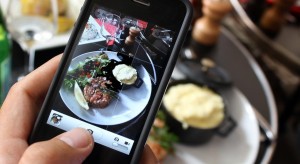“Hopefully no one ends up in jail.”
That’s what I told Susan Berfield of Bloomberg Business week when she asked me about #citizenfoodsafety, the project created to encourage regular folks to take and share pics of thermometer use, handwashing, restaurant scores and the likes.
Dani has been all about Instagram for the past couple of months and got me hooked on the voyeuristic excitement of following people through the photos they take. So much of what I see is food (I guess because I follow self-described foodies) – why not do the same thing with food safety.
Susan writes,
You could imagine all sorts of activity emerging from this, but for now, Chapman says he wants only to encourage foodies to ask questions about the safety of what they eat. It’s citizen science, not vigilantism. In this noble version of life on the Internet, the photos will be conversation starters. “There’s just too many illnesses from foodborne pathogens, about 48 million a year,” he says. “There’s a lot of interventions out there, and we haven’t seen the payoff in reduction of illnesses.” The latest salmonella outbreak has already sickened 278 people.
There’s also the possibility that someone will send him a photo of a Taco Bell employee licking a stack of taco shells. Whether it’s rats, a fast-food employee sneezing into your drink, or a dude eating Ramen noodles out of a bowl he made with his beard, Chapman wants to see it—in the name of education. “We’ve seen lipstick on a drinking glass, I’m sure we’ll see hair on pizza, cockroaches in restaurants,” he says. “There’s a yuck factor in those, but they’re not as risky as someone handling raw meat and then not washing their hands before making a salad.”
“This isn’t meant to out restaurants,” he says. Nor is he encouraging people to sneak onto corporate farms or into fast-food kitchens. But “if it does get crazy, that means people are interested,” he says.
Lydia Zuraw of the Food Safety News also wrote about the project:
Food and public-health voyeurism has been around for a while, Chapman says, adding, “The project became reality with the advent and improvement of smart phones and the rise of the interest in citizen science.”
In his post, Chapman references a 2005 program in South Korea that encouraged diners to take pictures of food-safety infractions in restaurants and submit them to health inspectors who could follow up and potentially fine the establishment. The United Kingdom since launched a similar program, and there have been multiple examples of pests in New York and Toronto shared online.
“Better dialogue around food safety isn’t just about awareness. It’s about increasing the value society puts on working towards producing foods in the safest way,” Chapman says. “More dialogue and more informed shoppers and eaters keeps pressure on everyone to do better.”
 verdict in an edible oil case that has shaken confidence in locally-produced food products.
verdict in an edible oil case that has shaken confidence in locally-produced food products.
